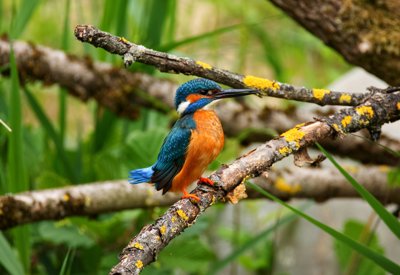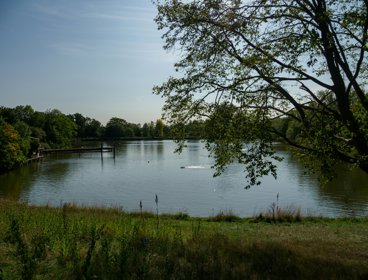Dr Meg Game is an ecologist for the City of London Corporation. She provides advice on the ecological management of Hampstead Heath as well as Highgate Wood and Queen’s Park in London. This advice aims to conserve the natural environment in these places and allow people to enjoy them. She conducts site surveys and monitors and writes management plans as well as liaising with staff, volunteers and members of the public. We talked to her about the Hampstead Heath Ponds Project.
What is the Hampstead Heath Ponds Project?
The Hampstead Heath Ponds Project is a complex engineering and landscaping project. Hampstead Heath is fortunate in having around thirty much-loved ponds, most of which are formed by man-made dams which are up to three hundred years old. The City of London Corporation is responsible for ensuring that the pond dams on Hampstead Heath are safe. With this in mind the City is carrying out works on two chains of ponds on Hampstead Heath. This work will ensure the dams on Hampstead Heath can withstand extreme rainfall events, and will include important ecological improvements. On both chains some work will occur at most ponds, but to reduce the impact at the more environmentally sensitive ponds, work will be concentrated at the Model Boating Pond on the Highgate Chain, and at the Catchpit Valley on the Hampstead Chain.
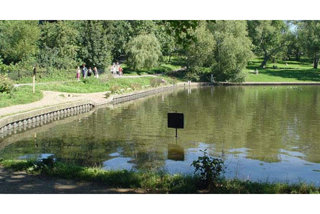
Hampstead Heath Ponds are attractive to both wildlife and visitors. (Source: City of London Corporation)
Why have such dramatic changes been planned?
Three of the ponds are large enough to be classed as 'large raised reservoirs' under the Reservoir Act 1975. This means they are subject to a statutory inspection regime by a government appointed panel engineer. This engineer has advised the City of London to take action to minimise the risk to life, property and infrastructure in North London. The City aims to limit the works while making the dams safe and minimising the impact on the natural environment of the Heath. As a result they have decided that it is preferable that the work should be carried out in a holistic way along the chains of ponds (rather than be confined to the three largest ponds). This is an approach supported by stakeholders and rather than being ‘dramatic’ actually spreads the load, allowing a more environmental, sensitive scheme. It will also avoid further potential works having to be undertaken in the future if the Flood and Water Management Act 2010 is fully implemented.
What makes the ponds ecologically special?
What makes the ponds special is their close proximity to Central London and the multitude of people who are able to enjoy them and the Heath. There are even three bathing ponds where the public can swim surrounded by nature. In the context of Britain as a whole the ponds’ ecology is not particularly special. However, Hampstead Heath is very good as far as bats are concerned. There are around nine species of bat found there. There is also a good range of common bird species that people can see, including the impressive looking kingfisher. People are able to enjoy fishing in the ponds, and can see a good variety of dragonflies. In short the Ponds, the Heath and their ecology add to urban life. It is a place where people can experience the countryside just six kilometres from Trafalgar Square in Central London.
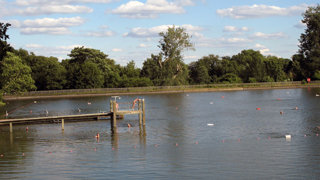
The Men’s bathing pond at Hampstead Heath. (Source: seanfoneill)
How does one start measuring the impact of a project such as this on local ecology?
In order to measure the impact of such a project it is important to know what species can be found in the area before work begins. Therefore a lot of time and money was put into surveying the main groups of plants and animals found in the areas where work would be occurring, including birds, bats, plants, amphibians, reptiles and insects. Though you cannot really survey all insects we look at just some as it is such an enormous group. We also looked at long term data we already had regarding the wildlife. When the work has been completed we will undertake further surveys and compare them with the surveys from before work began.
As well as surveying the wildlife we have looked at the environment itself. It particular we have been monitoring different aspects water quality, including dissolved oxygen levels and phosphorous. Water quality is to be monitored throughout the work for any signs of change.
What short term impacts might the project have on local ecology and are there any particular species that will need special attention during the works?
There will be some disturbance to certain species during the project, however we are doing everything we can to limit that. We are aware that it may disrupt a small number of nesting birds, for example coots who have in the past nested in a section of the Model Boating Pond that is going to be drained. We have had to dissuade birds from nesting in certain areas by netting off the vegetation, collecting sticks and other nesting materials as well as clearing scrubby vegetation in which they might nest. We have tried to plan the timetable of the works so there is limited disruption to nesting birds. Some trees have had to be cut down but this has a greater effect on the landscape than the ecology of the area. It should have minimal effect on birds as there are thousands of trees on the Heath and many birds, such as wrens and robins, usually prefer to nest in bramble and scrub.
There may be some disturbance to fish as we will be de-silting a number of the ponds. This may make the water more turbid and reduce oxygen levels. However, we will only be de-silting a part of any pond at any time, while oxygenating the water in the other part. This should encourage the fish away from the area being de-silted. A section of the Model Boating pond will be drained. We will drain it half way down, and then move any fish from that section to the main section of the pond. Then we will gradually drain the rest so that we can move any fish that were originally overlooked.
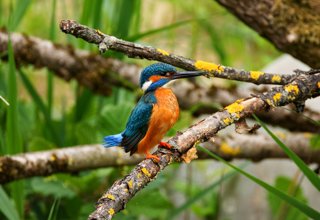
Kingfishers have been seen at the Hampstead Heath Ponds.
To what extent can species ‘migrate’ to other sites while the works are being carried out?
This depends very much on the species. Mobile species such as birds and bats can move away unless they are in the process of breeding. However, I do not expect there to be much impact on the wildlife of the Heath during the works so most will not need to migrate.
How might biodiversity be improved as a result of the project?
For this project I believe the net benefit will far outweigh any negative effect. The extra vegetation around the ponds and in the wildflower meadows will be much better than what we have now, and will encourage greater biodiversity. Using the Stock pond as an example, by cutting down some trees around the edges there will be much better light, which is beneficial for aquatic vegetation. It was a fairly stagnant pond, but after reducing the shade, de-silting and the addition of more marginal plants there will be much better water quality, benefiting a range of wildlife including fish, aquatic invertebrates, ducks, kingfisher and heron. Aquatic vegetation will be planted at a number of the ponds, and wild flowers sown on the newly built dams that will increase the plant diversity, which in turn can aid the diversity of other wildlife, like bees and butterflies.
Key Words
Dam
A barrier that holds back water within an aquatic system, often for the purpose of hydroelectric power generation and flood control.
Ecological Niche
The place within an ecosystem that a particular species occupies in terms of space and nutritional requirements.
Ecosystem
A set of living organisms that interact with non-living components to create a system of inputs, processes and outputs.
Habitat
An environmental setting that is occupied specifically by a particular species or set of related species.
Reservoir
A body of water that pools as a result of the placement of a dam.
Species
A classification of living organisms which are capable of interbreeding and producing fertile offspring.
Lesson Ideas
Choosing one of the species mentioned in the interview, students can research the particular ecological niche that that species occupies. From this students can create a list of ways in which the ponds at Hampstead Heath fulfil this niche.
Students can be asked to list the different factors that should be considered for an environmental impact assessment of the works that are being carried out on the ponds as part of the Hampstead Heath Ponds Project. Students may like to give these a weighting which compares how important each factor is, something which can lead into a further discussion.
Using the Hampstead Heath Ponds Project website and a blank map of the site (or an ArcGIS overview) students can annotate the map to show where the main works are taking place. They can also shade the ponds and their surroundings to show which areas would be most impacted (for good and bad) from an environmental and indeed social perspective.
Links
Ham and High: Local newspaper report on opposition to the plans
Meg was interviewed in May 2015
